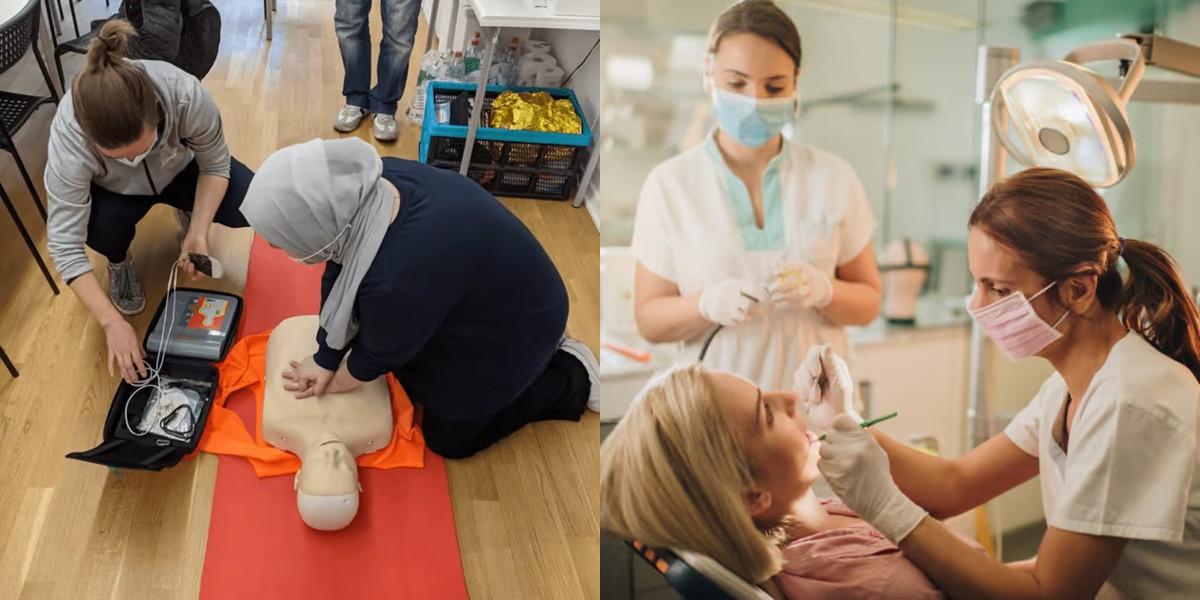CPR-BLS vs Dental Assistant

Key Points:
- CPR-BLS providers perform emergency life-saving procedures; Dental Assistants support dentists in various clinical and administrative tasks.
- CPR-BLS providers may earn less on average compared to Dental Assistants, who often have higher earning potential.
- Both have steady job opportunities, but Dental Assistant positions may be more widely available in some regions.
- CPR-BLS training is often shorter and can be done online, while Dental Assistant programs typically require in-person, longer-term training.
- CPR-BLS training is generally more affordable and faster to complete than Dental Assistant programs.
When it comes to choosing a career path in the healthcare field, there are many options available. Two popular choices are becoming a CPR-BLS (Cardiopulmonary Resuscitation-Basic Life Support) provider or a dental assistant. While both careers involve helping others and working in a healthcare setting, there are some key differences between the two. In this blog post, we will explore the roles and responsibilities of a CPR-BLS provider and a dental assistant, as well as the education and training required for each profession. We will also discuss the career outlook and salary potential for both CPR-BLS providers and dental assistants.
CPR-BLS
To become a CPR-BLS provider, individuals must complete a certification course. These courses typically cover topics such as:
- Basic life support techniques, including CPR, rescue breathing, and the use of automated external defibrillators (AEDs).
- Recognition and management of various medical emergencies.
- Techniques for providing care to adults, children, and infants.
- Communication and teamwork skills for working in emergency situations.
The length of CPR-BLS certification courses can vary, but they are typically completed in a few days or weeks. Some organizations offer online courses for added convenience.
Dental Assistant
The education and training requirements for dental assistants can vary depending on the state and the employer. Some dental assistants receive on-the-job training, while others complete a dental assisting program. These programs can range from several months to one year and may result in a certificate, diploma, or associate degree.
Dental assisting programs cover topics such as:
- Dental anatomy and terminology.
- Infection control and sterilization procedures.
- Dental radiography and X-ray techniques.
- Chairside assisting and dental procedures.
- Dental office management and patient communication.
In addition to completing a dental assisting program, some states require dental assistants to pass a licensing or registration exam.
CPR-BLS vs Dental Assistant: Career Outlook and Salary
CPR-BLS
The career outlook for CPR-BLS providers is generally positive. As the demand for healthcare services continues to grow, the need for trained emergency medical responders also increases. CPR-BLS providers may find employment in a variety of settings, including hospitals, clinics, fire departments, and ambulance services.
According to the Bureau of Labor Statistics (BLS), the median annual wage for emergency medical technicians (EMTs) and paramedics, which includes CPR-BLS providers, was $37,760 in May 2020. However, it's important to note that wages can vary depending on factors such as experience, location, and employer.
Dental Assistant
The career outlook for dental assistants is also favorable. The dental field is expected to grow in the coming years, driven by an aging population and increased emphasis on oral health. Dental assistants may find job opportunities in dental offices, clinics, hospitals, and other healthcare settings.
According to the Bureau of Labor Statistics (BLS), the median annual wage for dental assistants was $41,180 in May 2020. However, it's important to note that wages can vary depending on factors such as experience, education, location, and employer.
Final Thoughts
Choosing a career in healthcare is a rewarding decision, and both CPR-BLS providers and dental assistants play important roles in patient care. While CPR-BLS providers focus on emergency situations and resuscitation techniques, dental assistants provide support to dentists and ensure that dental offices run smoothly. The education and training requirements for both professions vary, but both offer opportunities for growth and advancement. Ultimately, the best career choice will depend on individual interests, skills, and goals.
Ensuring accessibility for individuals seeking growth, Dreambound strategically places its educational programs in various locations. Delve into a more comprehensive understanding of the exciting opportunities within these two vocations by visiting:

Fel is a student support representative who guides enrollees to the right program and answers their queries. She's committed to helping students and takes pride in her work. In her free time, she enjoys sightseeing and hanging out with loved ones.





